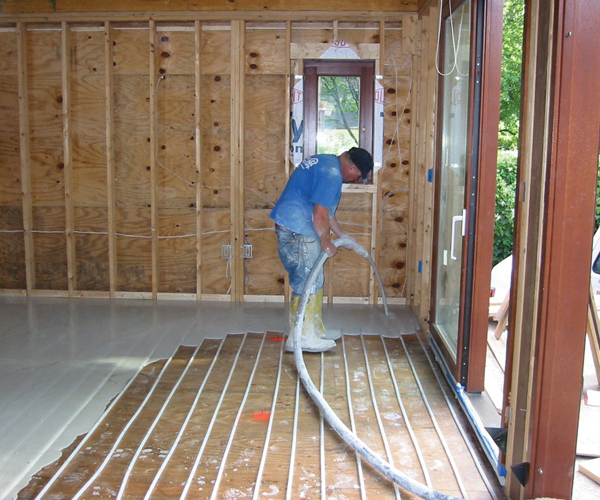Radiant floor heating the ultimate in savings and comfort

|
In an economic climate in which everyone wants top value for every dollar spent, increasing numbers of homeowners are choosing a surprisingly efficient and extremely comfortable form of home heating. They are opting for radiant floor heating.
Radiant heating is a form of hydronic (hot water) heating that distributes hot water from a centrally located boiler through highly durable plastic tubing installed in floors, walls or ceilings. This heating system is gentle and soothing with no drafts and no hot or cold spots in the home.
Stepping out of a shower onto a warm, radiant-heated bathroom floor feels like a supreme luxury, even on the coldest winter days and nights. Yet this luxurious heating comfort is extremely energy efficient because it warms the objects in the room, not the room air.
Radiant heating has actually been used since the time of the ancient Romans. Homeowners throughout the Far East and Europe have been using it for decades. And now, thousands of American homeowners are enjoying the comfort and high efficiency of radiant heating.
Radiant Heat Savings
In Architect's Home
"Aside from the unsurpassed heating comfort, there are cost benefits as well to a hydronic radiant installation," says Elizabeth A. Gibb, an architect in Cambridge, MA, and an assistant professor of architecture at Wentworth Institute of Technology.
"For our own home, we decided to embed the radiant tubing in a light-weight concrete slab poured on top of the plywood subfloor. This concrete slab helps provide the outstanding comfort and energy efficiency of hydronic radiant heating. The mass of the concrete retains the heat of the system. That means the homeowner continues to feel the warmth of the heating system at substantial operating cost savings."
After installing radiant heating in 2004, Ms. Gibb compared the heating cost of her previous 1,500 sq. ft. forced-air-heated townhouse condo with that of her new radiant-heated two-family house in Cambridge. "During the very coldest winter months of 2003-04," she says, "our heating costs at the condo were about $250-$300 per month (17-20 cents per sq. ft. per month). In our new 4,000 sq. ft. house, which is fully exposed at the roof and the entire perimeter of the house, the heating cost in 2004-05 was about $350-$400 per month (9-10 cents per sq. ft. per month). The operating cost savings were significant and with today's higher energy prices, the savings are even greater. For my money, the advantages of hydronic radiant heating are more than worth the additional installation costs."
Ms. Gibb says the additional installation costs for her hydronic radiant heating were for the light-weight concrete slab over the regular floor framing, additional structural framing to carry this added dead load of the framing, insulation under every interior floor, a separate AC system and recessed lighting fixtures rated for use with insulation.
In addition to room heating, other hydronic applications include domestic hot water heating, swimming pool and whirlpool heating, snow and ice melting for sidewalks and driveways and bathroom towel rack warming. Air conditioning may also be added to hydronically heated homes as a separate system. Hydronic heating is ideal for a newly constructed home or for an addition to an existing home.
Homeowners looking for extremely efficient heating -- and a delightful warm floor to step onto after a shower -- can ask their home heating contractor for all the facts about hydronic radiant heating, one of America's fastest-growing forms of home heating comfort. For more information, visit www.myhomeheating.com, or write to the Hydronics Industry Alliance, 8225 Madrillon Estates Drive, Vienna, VA 22182, or e-mail to myhomeheating@verizon.net.







